Analyzing UN Procurement and Logistics in the Rohingya Refugee Crisis
VerifiedAdded on 2022/09/11
|23
|7357
|18
Report
AI Summary
This report delves into the complexities of UN procurement and logistics within the context of the Rohingya refugee crisis in Cox's Bazar, Bangladesh. It begins with an introduction to the refugee crisis, the role of UNHCR, and the specific challenges faced by the Rohingya population. The report identifies the problem statement, research purpose, questions, aims, and objectives, emphasizing the need to analyze supply chain logistics and procurement practices. A comprehensive literature review explores supply chain management strategies, procurement and distribution theories, inventory management, and the unique challenges of humanitarian supply chains. The report then examines the current procurement and logistics practices, limitations, and gaps, offering recommendations for improvement. The study highlights the significance of this research in understanding global humanitarian crisis logistics and providing actionable insights for governments and aid organizations. The report also includes an analysis of the Economic Order Quantity (EOQ) and its importance in managing inventory effectively, alongside discussions on supply chain performance, risk management, and the role of information management in supply chains. The document provides a comprehensive analysis of the UN's procurement and logistics strategies in the Rohingya refugee crisis, identifying gaps and suggesting improvements for future humanitarian efforts.
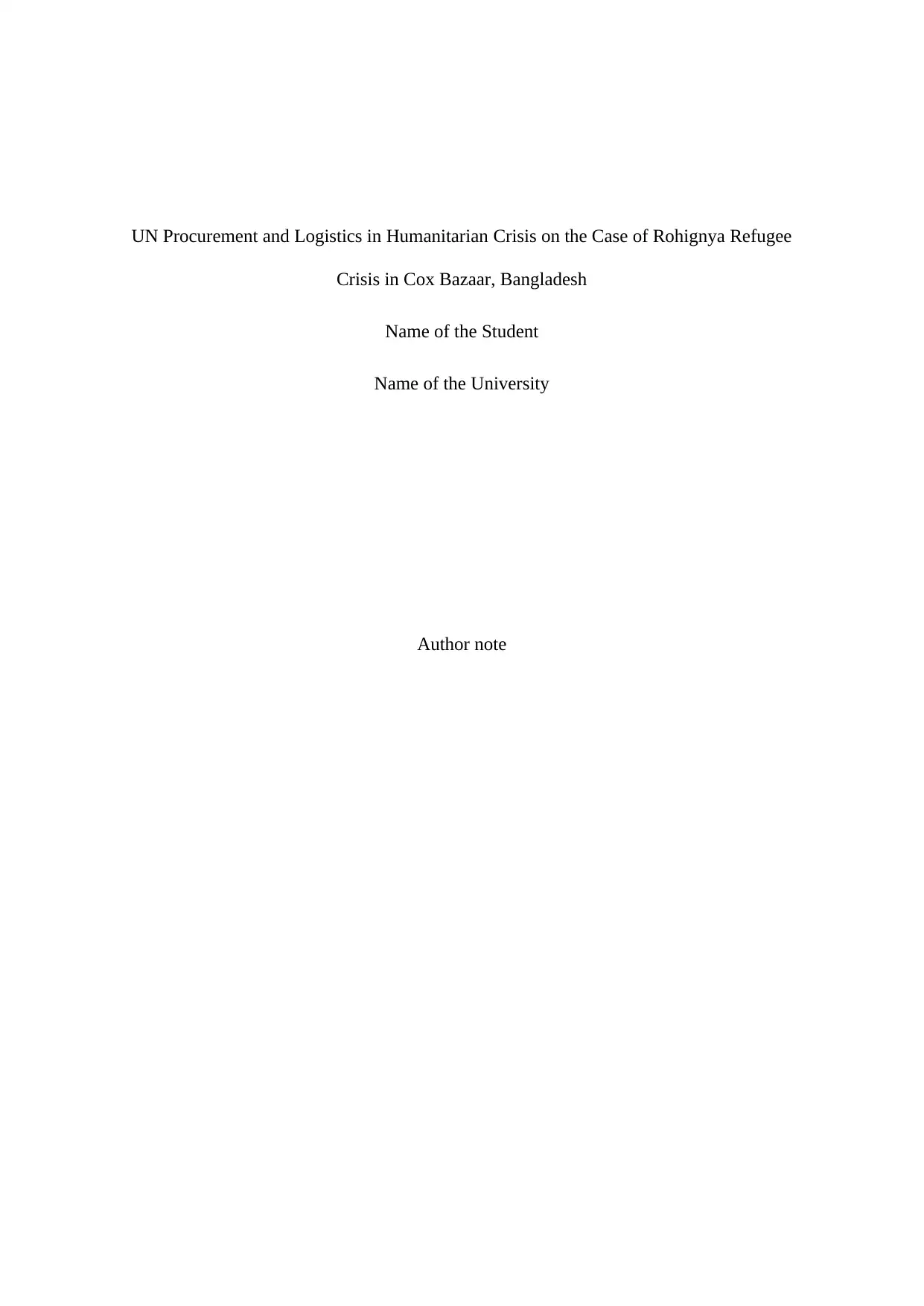
UN Procurement and Logistics in Humanitarian Crisis on the Case of Rohignya Refugee
Crisis in Cox Bazaar, Bangladesh
Name of the Student
Name of the University
Author note
Crisis in Cox Bazaar, Bangladesh
Name of the Student
Name of the University
Author note
Paraphrase This Document
Need a fresh take? Get an instant paraphrase of this document with our AI Paraphraser
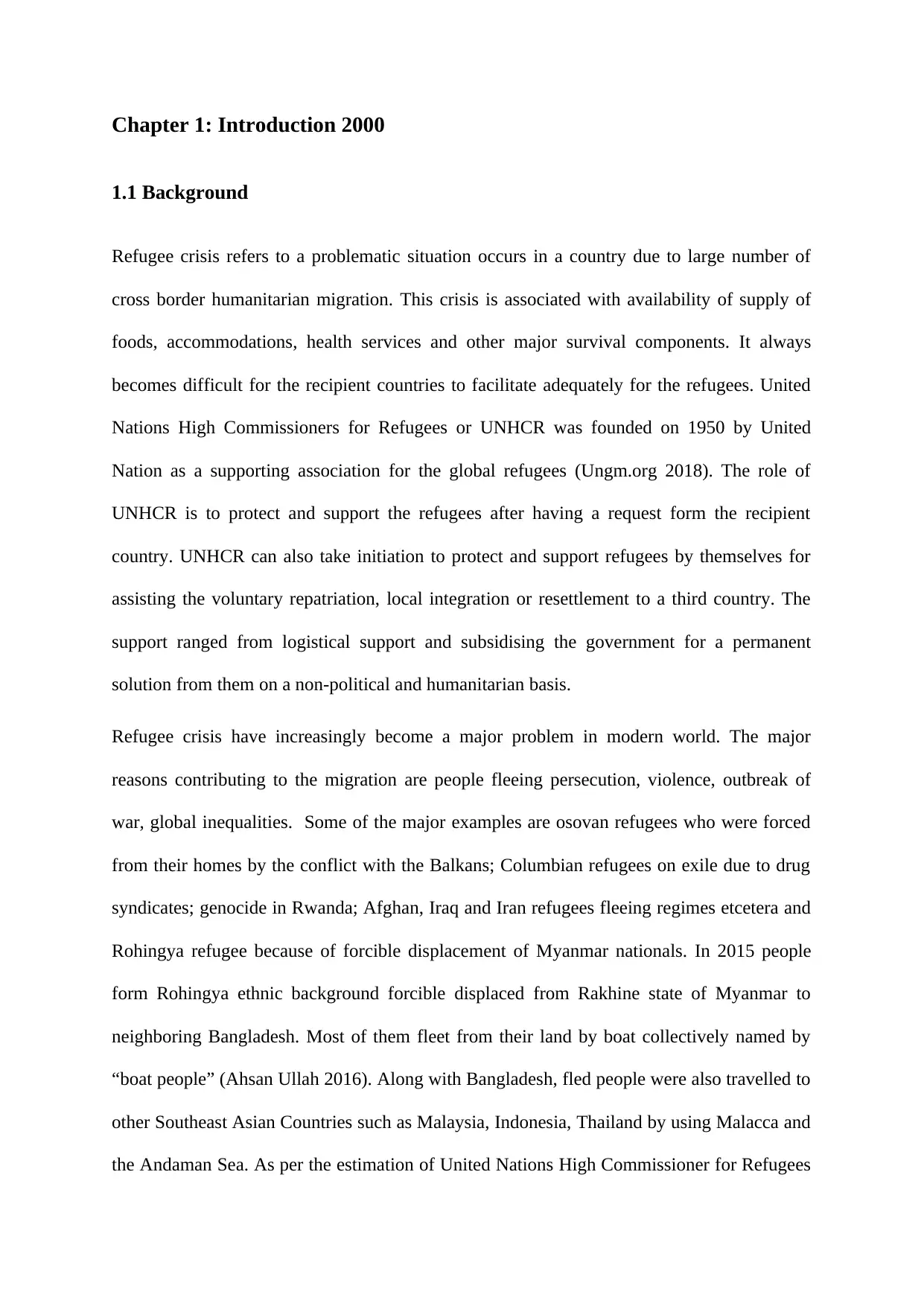
Chapter 1: Introduction 2000
1.1 Background
Refugee crisis refers to a problematic situation occurs in a country due to large number of
cross border humanitarian migration. This crisis is associated with availability of supply of
foods, accommodations, health services and other major survival components. It always
becomes difficult for the recipient countries to facilitate adequately for the refugees. United
Nations High Commissioners for Refugees or UNHCR was founded on 1950 by United
Nation as a supporting association for the global refugees (Ungm.org 2018). The role of
UNHCR is to protect and support the refugees after having a request form the recipient
country. UNHCR can also take initiation to protect and support refugees by themselves for
assisting the voluntary repatriation, local integration or resettlement to a third country. The
support ranged from logistical support and subsidising the government for a permanent
solution from them on a non-political and humanitarian basis.
Refugee crisis have increasingly become a major problem in modern world. The major
reasons contributing to the migration are people fleeing persecution, violence, outbreak of
war, global inequalities. Some of the major examples are osovan refugees who were forced
from their homes by the conflict with the Balkans; Columbian refugees on exile due to drug
syndicates; genocide in Rwanda; Afghan, Iraq and Iran refugees fleeing regimes etcetera and
Rohingya refugee because of forcible displacement of Myanmar nationals. In 2015 people
form Rohingya ethnic background forcible displaced from Rakhine state of Myanmar to
neighboring Bangladesh. Most of them fleet from their land by boat collectively named by
“boat people” (Ahsan Ullah 2016). Along with Bangladesh, fled people were also travelled to
other Southeast Asian Countries such as Malaysia, Indonesia, Thailand by using Malacca and
the Andaman Sea. As per the estimation of United Nations High Commissioner for Refugees
1.1 Background
Refugee crisis refers to a problematic situation occurs in a country due to large number of
cross border humanitarian migration. This crisis is associated with availability of supply of
foods, accommodations, health services and other major survival components. It always
becomes difficult for the recipient countries to facilitate adequately for the refugees. United
Nations High Commissioners for Refugees or UNHCR was founded on 1950 by United
Nation as a supporting association for the global refugees (Ungm.org 2018). The role of
UNHCR is to protect and support the refugees after having a request form the recipient
country. UNHCR can also take initiation to protect and support refugees by themselves for
assisting the voluntary repatriation, local integration or resettlement to a third country. The
support ranged from logistical support and subsidising the government for a permanent
solution from them on a non-political and humanitarian basis.
Refugee crisis have increasingly become a major problem in modern world. The major
reasons contributing to the migration are people fleeing persecution, violence, outbreak of
war, global inequalities. Some of the major examples are osovan refugees who were forced
from their homes by the conflict with the Balkans; Columbian refugees on exile due to drug
syndicates; genocide in Rwanda; Afghan, Iraq and Iran refugees fleeing regimes etcetera and
Rohingya refugee because of forcible displacement of Myanmar nationals. In 2015 people
form Rohingya ethnic background forcible displaced from Rakhine state of Myanmar to
neighboring Bangladesh. Most of them fleet from their land by boat collectively named by
“boat people” (Ahsan Ullah 2016). Along with Bangladesh, fled people were also travelled to
other Southeast Asian Countries such as Malaysia, Indonesia, Thailand by using Malacca and
the Andaman Sea. As per the estimation of United Nations High Commissioner for Refugees
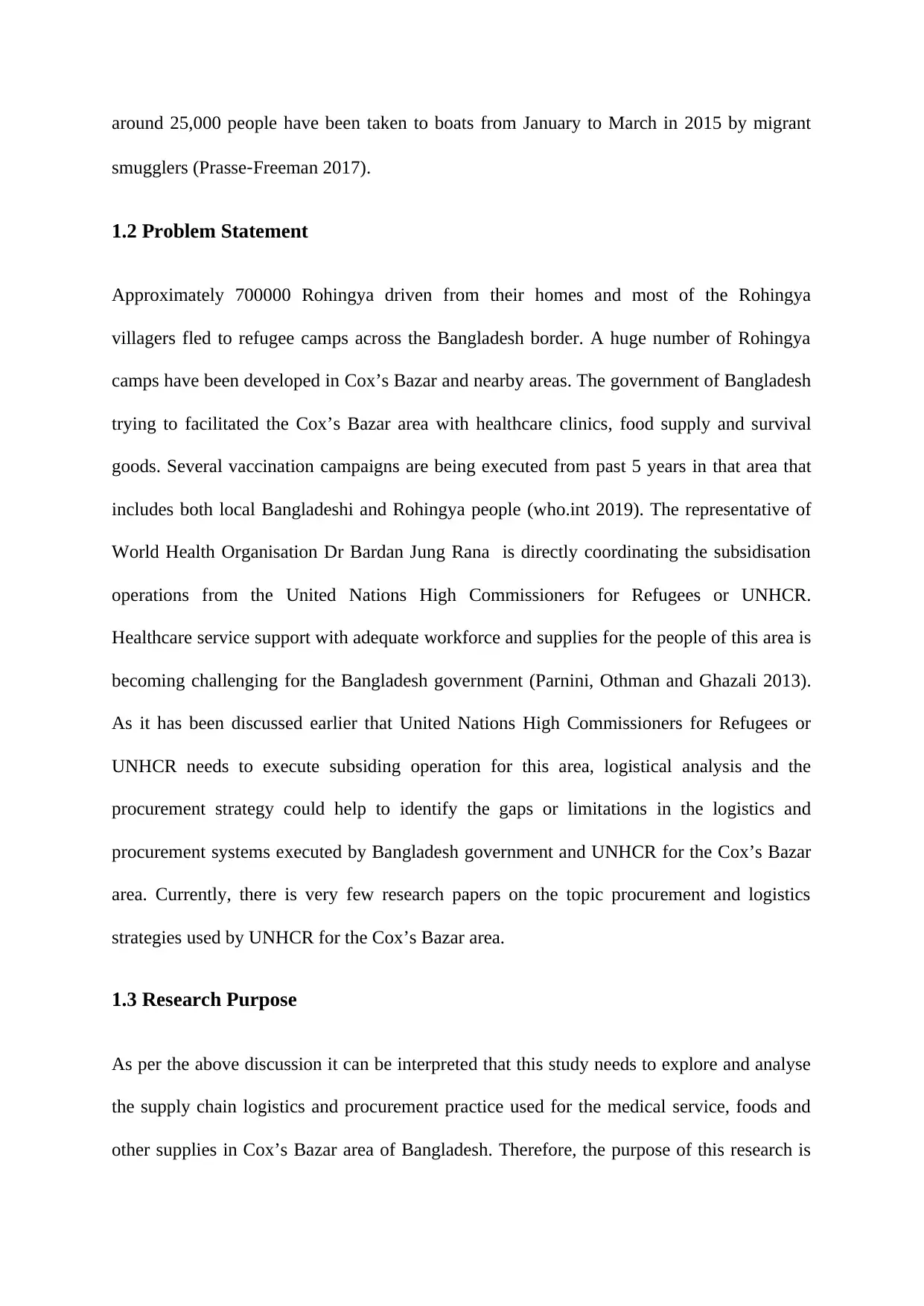
around 25,000 people have been taken to boats from January to March in 2015 by migrant
smugglers (Prasse‐Freeman 2017).
1.2 Problem Statement
Approximately 700000 Rohingya driven from their homes and most of the Rohingya
villagers fled to refugee camps across the Bangladesh border. A huge number of Rohingya
camps have been developed in Cox’s Bazar and nearby areas. The government of Bangladesh
trying to facilitated the Cox’s Bazar area with healthcare clinics, food supply and survival
goods. Several vaccination campaigns are being executed from past 5 years in that area that
includes both local Bangladeshi and Rohingya people (who.int 2019). The representative of
World Health Organisation Dr Bardan Jung Rana is directly coordinating the subsidisation
operations from the United Nations High Commissioners for Refugees or UNHCR.
Healthcare service support with adequate workforce and supplies for the people of this area is
becoming challenging for the Bangladesh government (Parnini, Othman and Ghazali 2013).
As it has been discussed earlier that United Nations High Commissioners for Refugees or
UNHCR needs to execute subsiding operation for this area, logistical analysis and the
procurement strategy could help to identify the gaps or limitations in the logistics and
procurement systems executed by Bangladesh government and UNHCR for the Cox’s Bazar
area. Currently, there is very few research papers on the topic procurement and logistics
strategies used by UNHCR for the Cox’s Bazar area.
1.3 Research Purpose
As per the above discussion it can be interpreted that this study needs to explore and analyse
the supply chain logistics and procurement practice used for the medical service, foods and
other supplies in Cox’s Bazar area of Bangladesh. Therefore, the purpose of this research is
smugglers (Prasse‐Freeman 2017).
1.2 Problem Statement
Approximately 700000 Rohingya driven from their homes and most of the Rohingya
villagers fled to refugee camps across the Bangladesh border. A huge number of Rohingya
camps have been developed in Cox’s Bazar and nearby areas. The government of Bangladesh
trying to facilitated the Cox’s Bazar area with healthcare clinics, food supply and survival
goods. Several vaccination campaigns are being executed from past 5 years in that area that
includes both local Bangladeshi and Rohingya people (who.int 2019). The representative of
World Health Organisation Dr Bardan Jung Rana is directly coordinating the subsidisation
operations from the United Nations High Commissioners for Refugees or UNHCR.
Healthcare service support with adequate workforce and supplies for the people of this area is
becoming challenging for the Bangladesh government (Parnini, Othman and Ghazali 2013).
As it has been discussed earlier that United Nations High Commissioners for Refugees or
UNHCR needs to execute subsiding operation for this area, logistical analysis and the
procurement strategy could help to identify the gaps or limitations in the logistics and
procurement systems executed by Bangladesh government and UNHCR for the Cox’s Bazar
area. Currently, there is very few research papers on the topic procurement and logistics
strategies used by UNHCR for the Cox’s Bazar area.
1.3 Research Purpose
As per the above discussion it can be interpreted that this study needs to explore and analyse
the supply chain logistics and procurement practice used for the medical service, foods and
other supplies in Cox’s Bazar area of Bangladesh. Therefore, the purpose of this research is
⊘ This is a preview!⊘
Do you want full access?
Subscribe today to unlock all pages.

Trusted by 1+ million students worldwide
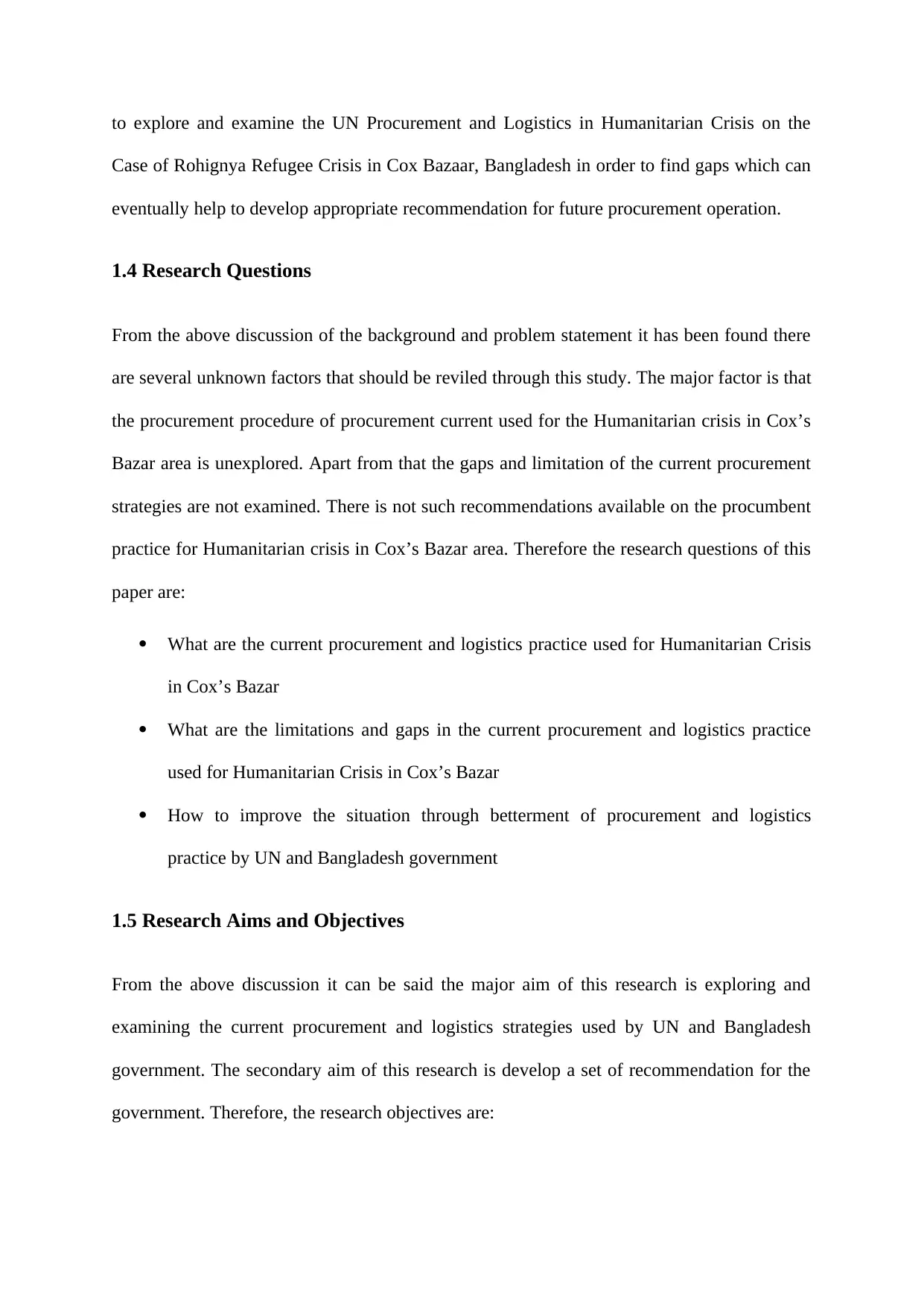
to explore and examine the UN Procurement and Logistics in Humanitarian Crisis on the
Case of Rohignya Refugee Crisis in Cox Bazaar, Bangladesh in order to find gaps which can
eventually help to develop appropriate recommendation for future procurement operation.
1.4 Research Questions
From the above discussion of the background and problem statement it has been found there
are several unknown factors that should be reviled through this study. The major factor is that
the procurement procedure of procurement current used for the Humanitarian crisis in Cox’s
Bazar area is unexplored. Apart from that the gaps and limitation of the current procurement
strategies are not examined. There is not such recommendations available on the procumbent
practice for Humanitarian crisis in Cox’s Bazar area. Therefore the research questions of this
paper are:
What are the current procurement and logistics practice used for Humanitarian Crisis
in Cox’s Bazar
What are the limitations and gaps in the current procurement and logistics practice
used for Humanitarian Crisis in Cox’s Bazar
How to improve the situation through betterment of procurement and logistics
practice by UN and Bangladesh government
1.5 Research Aims and Objectives
From the above discussion it can be said the major aim of this research is exploring and
examining the current procurement and logistics strategies used by UN and Bangladesh
government. The secondary aim of this research is develop a set of recommendation for the
government. Therefore, the research objectives are:
Case of Rohignya Refugee Crisis in Cox Bazaar, Bangladesh in order to find gaps which can
eventually help to develop appropriate recommendation for future procurement operation.
1.4 Research Questions
From the above discussion of the background and problem statement it has been found there
are several unknown factors that should be reviled through this study. The major factor is that
the procurement procedure of procurement current used for the Humanitarian crisis in Cox’s
Bazar area is unexplored. Apart from that the gaps and limitation of the current procurement
strategies are not examined. There is not such recommendations available on the procumbent
practice for Humanitarian crisis in Cox’s Bazar area. Therefore the research questions of this
paper are:
What are the current procurement and logistics practice used for Humanitarian Crisis
in Cox’s Bazar
What are the limitations and gaps in the current procurement and logistics practice
used for Humanitarian Crisis in Cox’s Bazar
How to improve the situation through betterment of procurement and logistics
practice by UN and Bangladesh government
1.5 Research Aims and Objectives
From the above discussion it can be said the major aim of this research is exploring and
examining the current procurement and logistics strategies used by UN and Bangladesh
government. The secondary aim of this research is develop a set of recommendation for the
government. Therefore, the research objectives are:
Paraphrase This Document
Need a fresh take? Get an instant paraphrase of this document with our AI Paraphraser
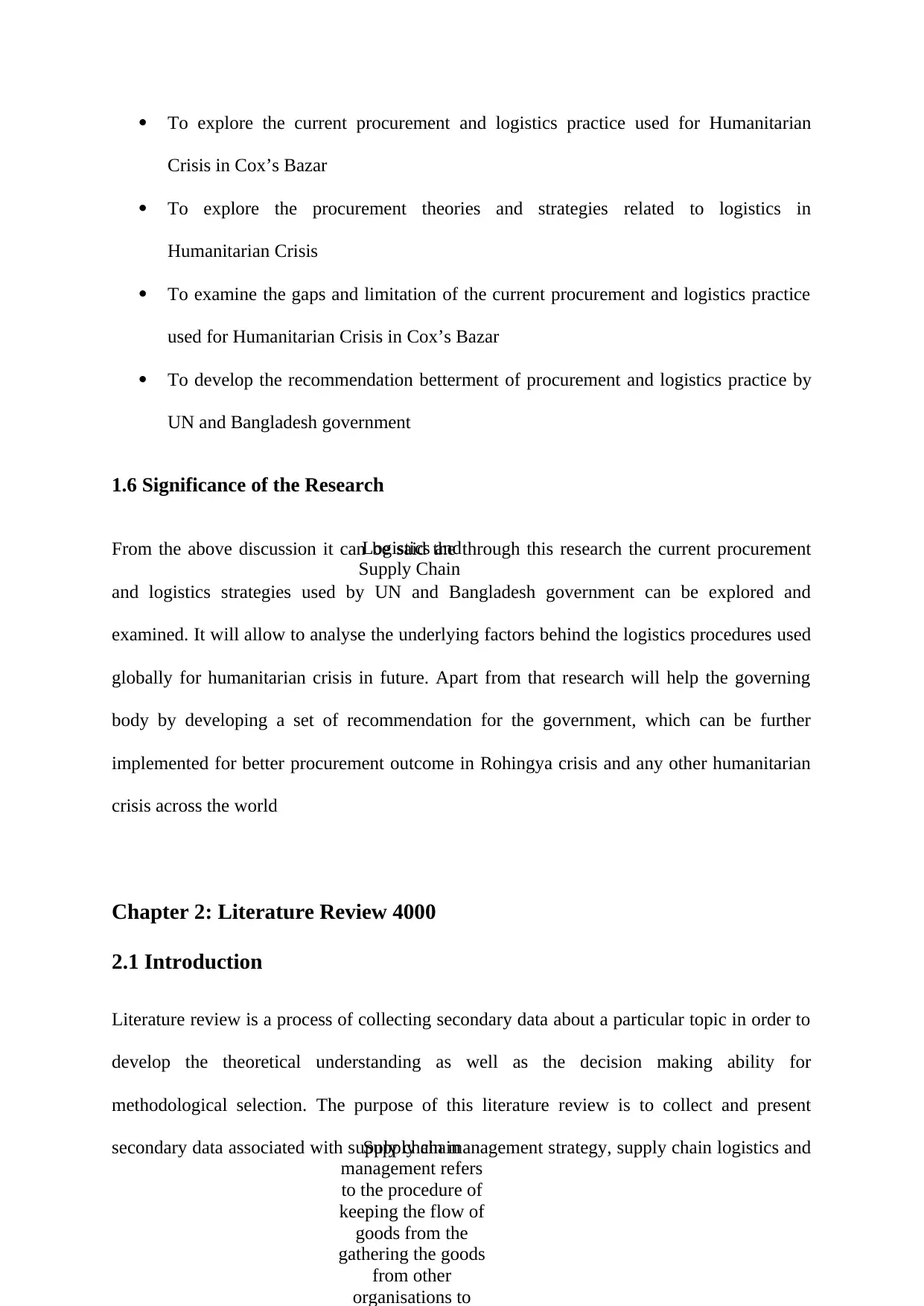
Logistics and
Supply Chain
Supply chain
management refers
to the procedure of
keeping the flow of
goods from the
gathering the goods
from other
organisations to
To explore the current procurement and logistics practice used for Humanitarian
Crisis in Cox’s Bazar
To explore the procurement theories and strategies related to logistics in
Humanitarian Crisis
To examine the gaps and limitation of the current procurement and logistics practice
used for Humanitarian Crisis in Cox’s Bazar
To develop the recommendation betterment of procurement and logistics practice by
UN and Bangladesh government
1.6 Significance of the Research
From the above discussion it can be said the through this research the current procurement
and logistics strategies used by UN and Bangladesh government can be explored and
examined. It will allow to analyse the underlying factors behind the logistics procedures used
globally for humanitarian crisis in future. Apart from that research will help the governing
body by developing a set of recommendation for the government, which can be further
implemented for better procurement outcome in Rohingya crisis and any other humanitarian
crisis across the world
Chapter 2: Literature Review 4000
2.1 Introduction
Literature review is a process of collecting secondary data about a particular topic in order to
develop the theoretical understanding as well as the decision making ability for
methodological selection. The purpose of this literature review is to collect and present
secondary data associated with supply chain management strategy, supply chain logistics and
Supply Chain
Supply chain
management refers
to the procedure of
keeping the flow of
goods from the
gathering the goods
from other
organisations to
To explore the current procurement and logistics practice used for Humanitarian
Crisis in Cox’s Bazar
To explore the procurement theories and strategies related to logistics in
Humanitarian Crisis
To examine the gaps and limitation of the current procurement and logistics practice
used for Humanitarian Crisis in Cox’s Bazar
To develop the recommendation betterment of procurement and logistics practice by
UN and Bangladesh government
1.6 Significance of the Research
From the above discussion it can be said the through this research the current procurement
and logistics strategies used by UN and Bangladesh government can be explored and
examined. It will allow to analyse the underlying factors behind the logistics procedures used
globally for humanitarian crisis in future. Apart from that research will help the governing
body by developing a set of recommendation for the government, which can be further
implemented for better procurement outcome in Rohingya crisis and any other humanitarian
crisis across the world
Chapter 2: Literature Review 4000
2.1 Introduction
Literature review is a process of collecting secondary data about a particular topic in order to
develop the theoretical understanding as well as the decision making ability for
methodological selection. The purpose of this literature review is to collect and present
secondary data associated with supply chain management strategy, supply chain logistics and
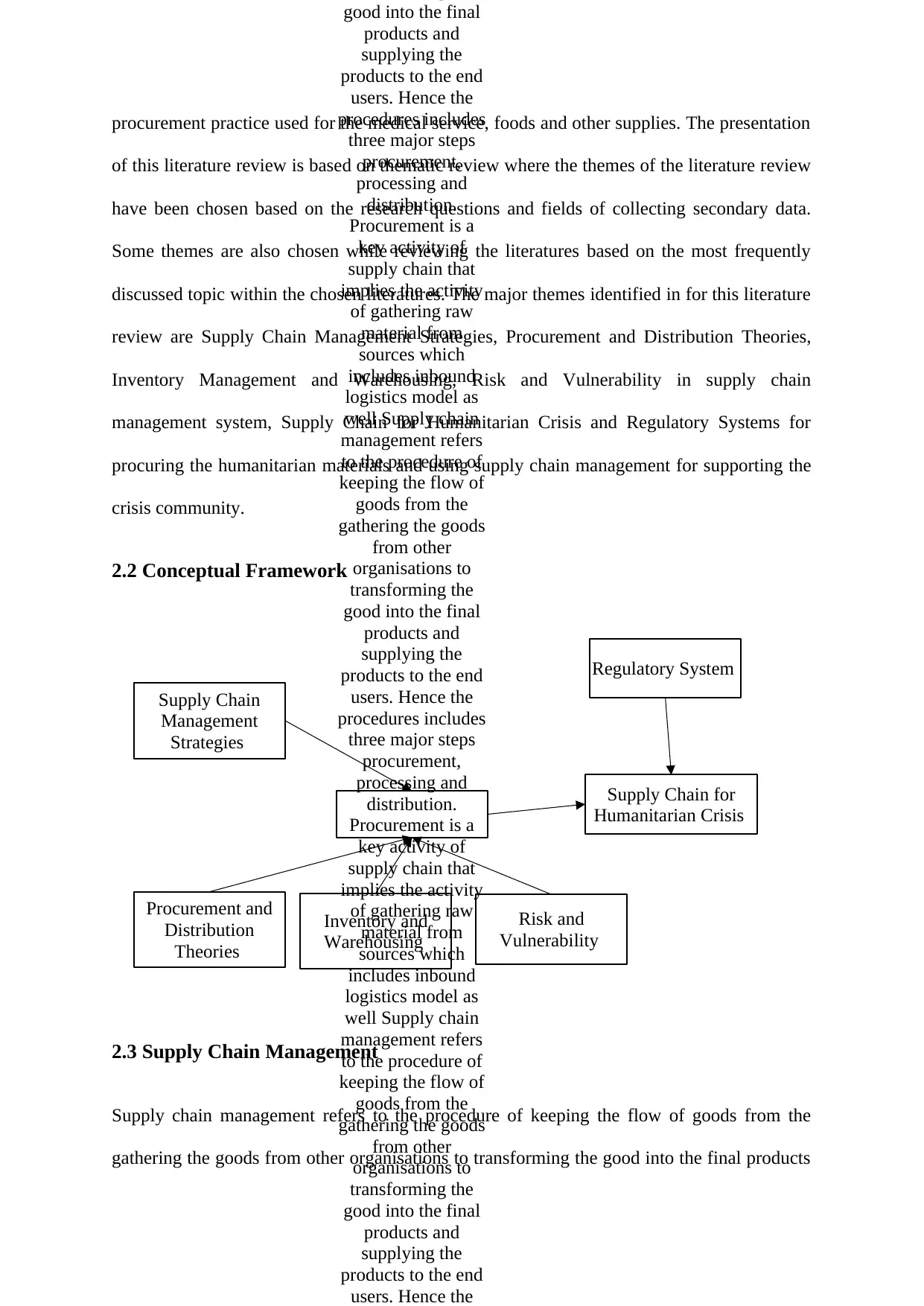
Supply Chain
Management
Strategies
good into the final
products and
supplying the
products to the end
users. Hence the
procedures includes
three major steps
procurement,
processing and
distribution.
Procurement is a
key activity of
supply chain that
implies the activity
of gathering raw
material from
sources which
includes inbound
logistics model as
well Supply chain
management refers
to the procedure of
keeping the flow of
goods from the
gathering the goods
from other
organisations to
transforming the
good into the final
products and
supplying the
products to the end
users. Hence the
procedures includes
three major steps
procurement,
processing and
distribution.
Procurement is a
key activity of
supply chain that
implies the activity
of gathering raw
material from
sources which
includes inbound
logistics model as
well Supply chain
management refers
to the procedure of
keeping the flow of
goods from the
gathering the goods
from other
organisations to
transforming the
good into the final
products and
supplying the
products to the end
users. Hence the
Procurement and
Distribution
Theories
Inventory and
Warehousing
Risk and
Vulnerability
Regulatory System
Supply Chain for
Humanitarian Crisis
procurement practice used for the medical service, foods and other supplies. The presentation
of this literature review is based on thematic review where the themes of the literature review
have been chosen based on the research questions and fields of collecting secondary data.
Some themes are also chosen while reviewing the literatures based on the most frequently
discussed topic within the chosen literatures. The major themes identified in for this literature
review are Supply Chain Management Strategies, Procurement and Distribution Theories,
Inventory Management and Warehousing, Risk and Vulnerability in supply chain
management system, Supply Chain for Humanitarian Crisis and Regulatory Systems for
procuring the humanitarian materials and using supply chain management for supporting the
crisis community.
2.2 Conceptual Framework
2.3 Supply Chain Management
Supply chain management refers to the procedure of keeping the flow of goods from the
gathering the goods from other organisations to transforming the good into the final products
Management
Strategies
good into the final
products and
supplying the
products to the end
users. Hence the
procedures includes
three major steps
procurement,
processing and
distribution.
Procurement is a
key activity of
supply chain that
implies the activity
of gathering raw
material from
sources which
includes inbound
logistics model as
well Supply chain
management refers
to the procedure of
keeping the flow of
goods from the
gathering the goods
from other
organisations to
transforming the
good into the final
products and
supplying the
products to the end
users. Hence the
procedures includes
three major steps
procurement,
processing and
distribution.
Procurement is a
key activity of
supply chain that
implies the activity
of gathering raw
material from
sources which
includes inbound
logistics model as
well Supply chain
management refers
to the procedure of
keeping the flow of
goods from the
gathering the goods
from other
organisations to
transforming the
good into the final
products and
supplying the
products to the end
users. Hence the
Procurement and
Distribution
Theories
Inventory and
Warehousing
Risk and
Vulnerability
Regulatory System
Supply Chain for
Humanitarian Crisis
procurement practice used for the medical service, foods and other supplies. The presentation
of this literature review is based on thematic review where the themes of the literature review
have been chosen based on the research questions and fields of collecting secondary data.
Some themes are also chosen while reviewing the literatures based on the most frequently
discussed topic within the chosen literatures. The major themes identified in for this literature
review are Supply Chain Management Strategies, Procurement and Distribution Theories,
Inventory Management and Warehousing, Risk and Vulnerability in supply chain
management system, Supply Chain for Humanitarian Crisis and Regulatory Systems for
procuring the humanitarian materials and using supply chain management for supporting the
crisis community.
2.2 Conceptual Framework
2.3 Supply Chain Management
Supply chain management refers to the procedure of keeping the flow of goods from the
gathering the goods from other organisations to transforming the good into the final products
⊘ This is a preview!⊘
Do you want full access?
Subscribe today to unlock all pages.

Trusted by 1+ million students worldwide
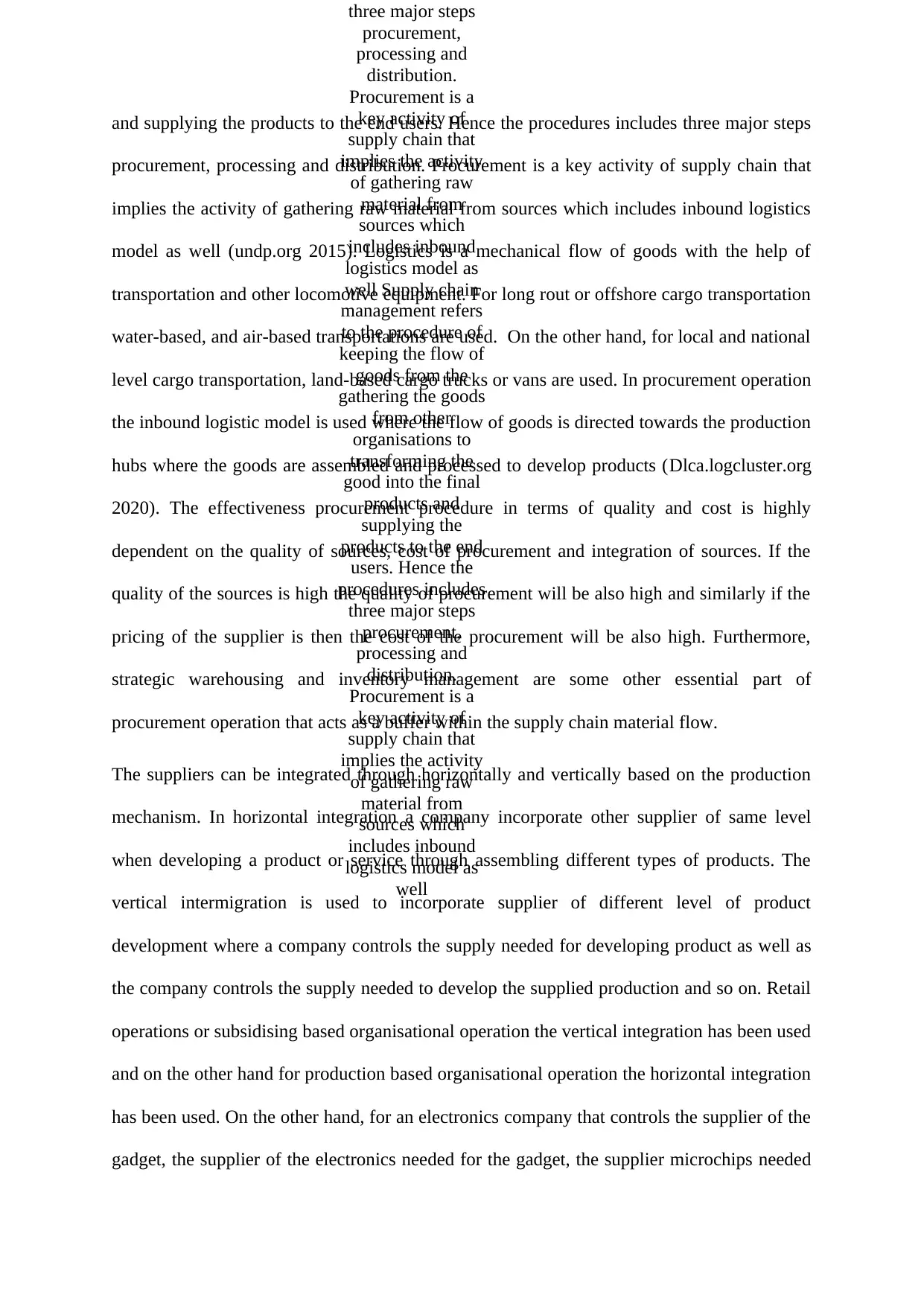
three major steps
procurement,
processing and
distribution.
Procurement is a
key activity of
supply chain that
implies the activity
of gathering raw
material from
sources which
includes inbound
logistics model as
well Supply chain
management refers
to the procedure of
keeping the flow of
goods from the
gathering the goods
from other
organisations to
transforming the
good into the final
products and
supplying the
products to the end
users. Hence the
procedures includes
three major steps
procurement,
processing and
distribution.
Procurement is a
key activity of
supply chain that
implies the activity
of gathering raw
material from
sources which
includes inbound
logistics model as
well
and supplying the products to the end users. Hence the procedures includes three major steps
procurement, processing and distribution. Procurement is a key activity of supply chain that
implies the activity of gathering raw material from sources which includes inbound logistics
model as well (undp.org 2015). Logistics is a mechanical flow of goods with the help of
transportation and other locomotive equipment. For long rout or offshore cargo transportation
water-based, and air-based transportations are used. On the other hand, for local and national
level cargo transportation, land-based cargo trucks or vans are used. In procurement operation
the inbound logistic model is used where the flow of goods is directed towards the production
hubs where the goods are assembled and processed to develop products (Dlca.logcluster.org
2020). The effectiveness procurement procedure in terms of quality and cost is highly
dependent on the quality of sources, cost of procurement and integration of sources. If the
quality of the sources is high the quality of procurement will be also high and similarly if the
pricing of the supplier is then the cost of the procurement will be also high. Furthermore,
strategic warehousing and inventory management are some other essential part of
procurement operation that acts as a buffer within the supply chain material flow.
The suppliers can be integrated through horizontally and vertically based on the production
mechanism. In horizontal integration a company incorporate other supplier of same level
when developing a product or service through assembling different types of products. The
vertical intermigration is used to incorporate supplier of different level of product
development where a company controls the supply needed for developing product as well as
the company controls the supply needed to develop the supplied production and so on. Retail
operations or subsidising based organisational operation the vertical integration has been used
and on the other hand for production based organisational operation the horizontal integration
has been used. On the other hand, for an electronics company that controls the supplier of the
gadget, the supplier of the electronics needed for the gadget, the supplier microchips needed
procurement,
processing and
distribution.
Procurement is a
key activity of
supply chain that
implies the activity
of gathering raw
material from
sources which
includes inbound
logistics model as
well Supply chain
management refers
to the procedure of
keeping the flow of
goods from the
gathering the goods
from other
organisations to
transforming the
good into the final
products and
supplying the
products to the end
users. Hence the
procedures includes
three major steps
procurement,
processing and
distribution.
Procurement is a
key activity of
supply chain that
implies the activity
of gathering raw
material from
sources which
includes inbound
logistics model as
well
and supplying the products to the end users. Hence the procedures includes three major steps
procurement, processing and distribution. Procurement is a key activity of supply chain that
implies the activity of gathering raw material from sources which includes inbound logistics
model as well (undp.org 2015). Logistics is a mechanical flow of goods with the help of
transportation and other locomotive equipment. For long rout or offshore cargo transportation
water-based, and air-based transportations are used. On the other hand, for local and national
level cargo transportation, land-based cargo trucks or vans are used. In procurement operation
the inbound logistic model is used where the flow of goods is directed towards the production
hubs where the goods are assembled and processed to develop products (Dlca.logcluster.org
2020). The effectiveness procurement procedure in terms of quality and cost is highly
dependent on the quality of sources, cost of procurement and integration of sources. If the
quality of the sources is high the quality of procurement will be also high and similarly if the
pricing of the supplier is then the cost of the procurement will be also high. Furthermore,
strategic warehousing and inventory management are some other essential part of
procurement operation that acts as a buffer within the supply chain material flow.
The suppliers can be integrated through horizontally and vertically based on the production
mechanism. In horizontal integration a company incorporate other supplier of same level
when developing a product or service through assembling different types of products. The
vertical intermigration is used to incorporate supplier of different level of product
development where a company controls the supply needed for developing product as well as
the company controls the supply needed to develop the supplied production and so on. Retail
operations or subsidising based organisational operation the vertical integration has been used
and on the other hand for production based organisational operation the horizontal integration
has been used. On the other hand, for an electronics company that controls the supplier of the
gadget, the supplier of the electronics needed for the gadget, the supplier microchips needed
Paraphrase This Document
Need a fresh take? Get an instant paraphrase of this document with our AI Paraphraser
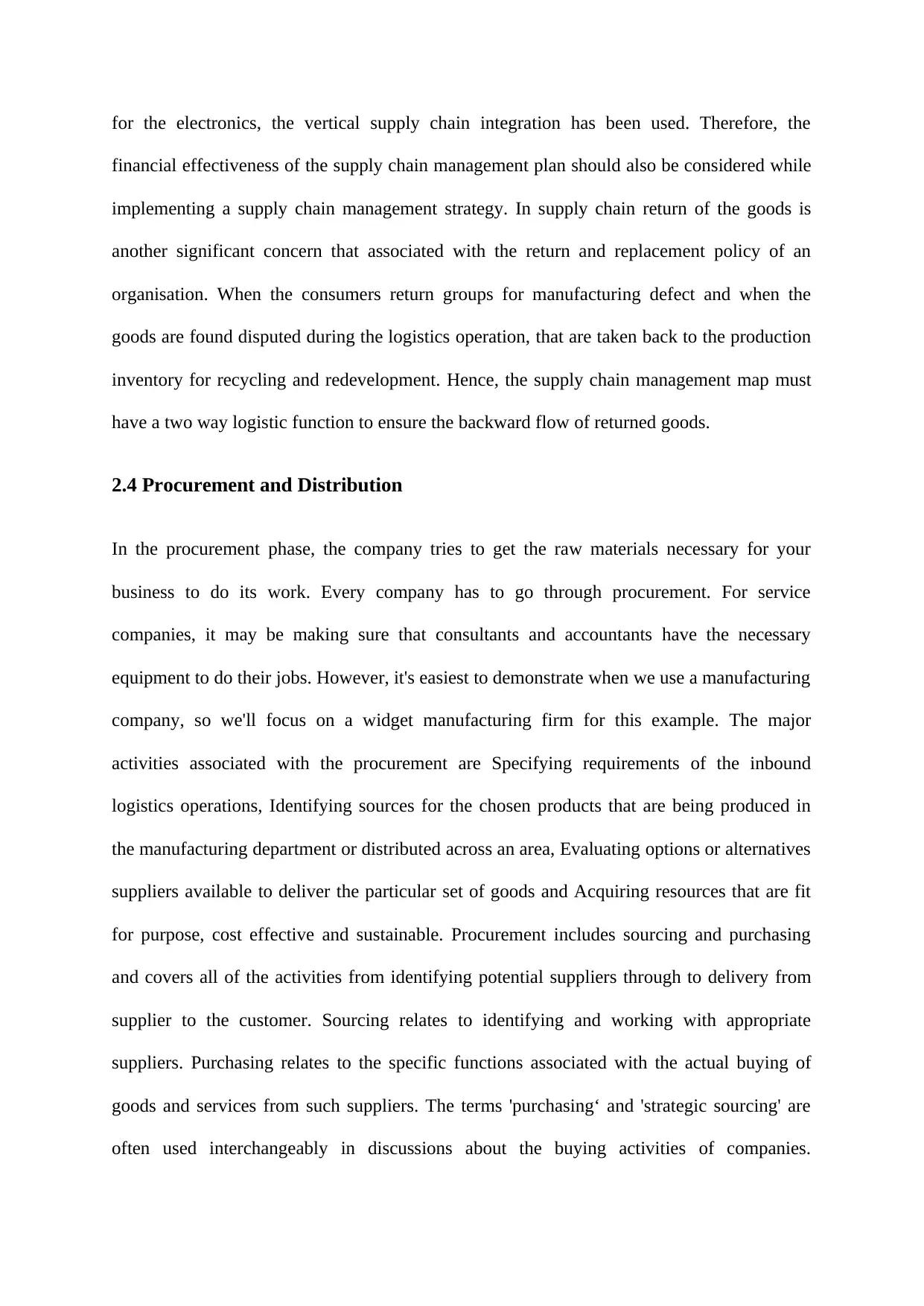
for the electronics, the vertical supply chain integration has been used. Therefore, the
financial effectiveness of the supply chain management plan should also be considered while
implementing a supply chain management strategy. In supply chain return of the goods is
another significant concern that associated with the return and replacement policy of an
organisation. When the consumers return groups for manufacturing defect and when the
goods are found disputed during the logistics operation, that are taken back to the production
inventory for recycling and redevelopment. Hence, the supply chain management map must
have a two way logistic function to ensure the backward flow of returned goods.
2.4 Procurement and Distribution
In the procurement phase, the company tries to get the raw materials necessary for your
business to do its work. Every company has to go through procurement. For service
companies, it may be making sure that consultants and accountants have the necessary
equipment to do their jobs. However, it's easiest to demonstrate when we use a manufacturing
company, so we'll focus on a widget manufacturing firm for this example. The major
activities associated with the procurement are Specifying requirements of the inbound
logistics operations, Identifying sources for the chosen products that are being produced in
the manufacturing department or distributed across an area, Evaluating options or alternatives
suppliers available to deliver the particular set of goods and Acquiring resources that are fit
for purpose, cost effective and sustainable. Procurement includes sourcing and purchasing
and covers all of the activities from identifying potential suppliers through to delivery from
supplier to the customer. Sourcing relates to identifying and working with appropriate
suppliers. Purchasing relates to the specific functions associated with the actual buying of
goods and services from such suppliers. The terms 'purchasing‘ and 'strategic sourcing' are
often used interchangeably in discussions about the buying activities of companies.
financial effectiveness of the supply chain management plan should also be considered while
implementing a supply chain management strategy. In supply chain return of the goods is
another significant concern that associated with the return and replacement policy of an
organisation. When the consumers return groups for manufacturing defect and when the
goods are found disputed during the logistics operation, that are taken back to the production
inventory for recycling and redevelopment. Hence, the supply chain management map must
have a two way logistic function to ensure the backward flow of returned goods.
2.4 Procurement and Distribution
In the procurement phase, the company tries to get the raw materials necessary for your
business to do its work. Every company has to go through procurement. For service
companies, it may be making sure that consultants and accountants have the necessary
equipment to do their jobs. However, it's easiest to demonstrate when we use a manufacturing
company, so we'll focus on a widget manufacturing firm for this example. The major
activities associated with the procurement are Specifying requirements of the inbound
logistics operations, Identifying sources for the chosen products that are being produced in
the manufacturing department or distributed across an area, Evaluating options or alternatives
suppliers available to deliver the particular set of goods and Acquiring resources that are fit
for purpose, cost effective and sustainable. Procurement includes sourcing and purchasing
and covers all of the activities from identifying potential suppliers through to delivery from
supplier to the customer. Sourcing relates to identifying and working with appropriate
suppliers. Purchasing relates to the specific functions associated with the actual buying of
goods and services from such suppliers. The terms 'purchasing‘ and 'strategic sourcing' are
often used interchangeably in discussions about the buying activities of companies.
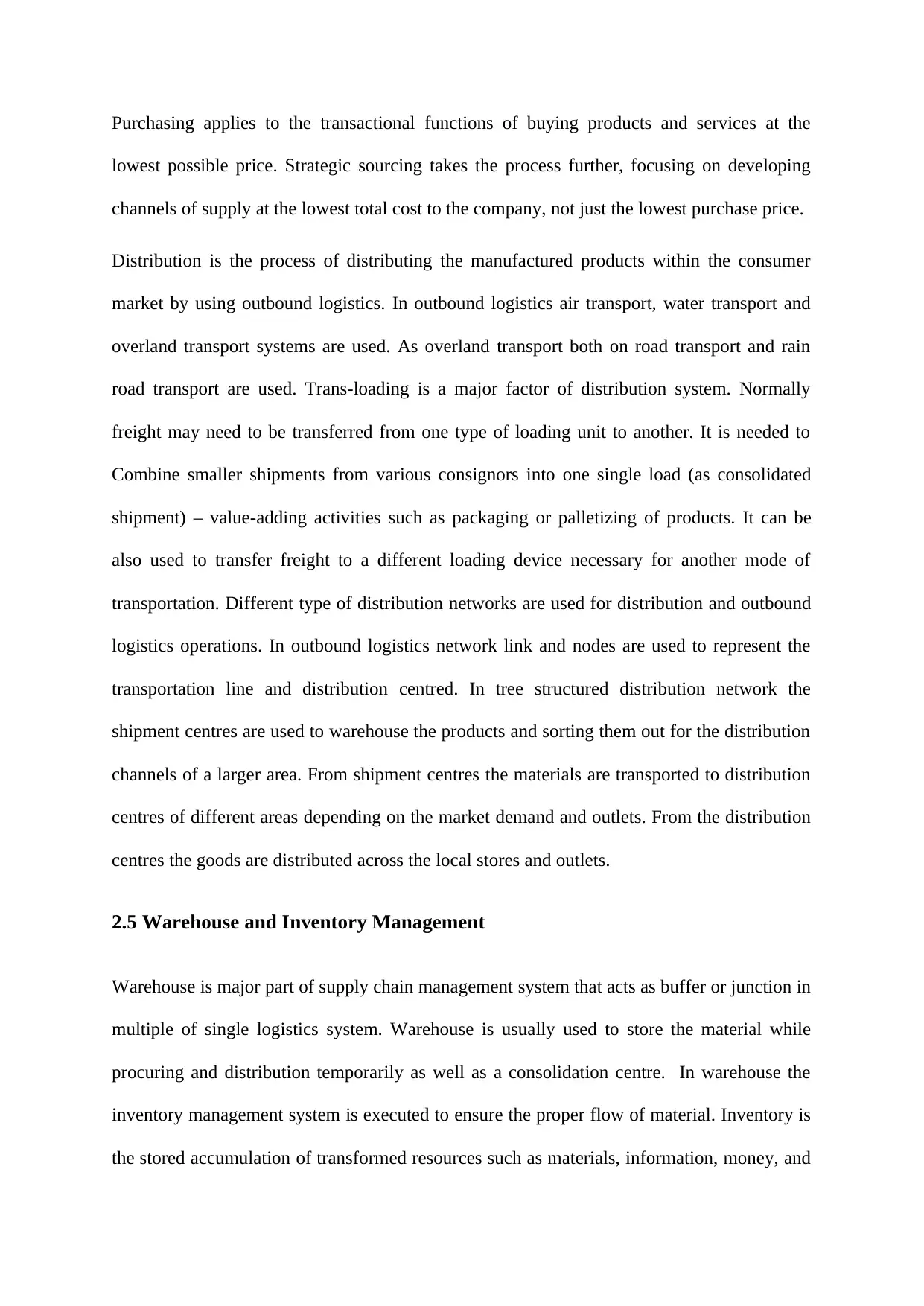
Purchasing applies to the transactional functions of buying products and services at the
lowest possible price. Strategic sourcing takes the process further, focusing on developing
channels of supply at the lowest total cost to the company, not just the lowest purchase price.
Distribution is the process of distributing the manufactured products within the consumer
market by using outbound logistics. In outbound logistics air transport, water transport and
overland transport systems are used. As overland transport both on road transport and rain
road transport are used. Trans-loading is a major factor of distribution system. Normally
freight may need to be transferred from one type of loading unit to another. It is needed to
Combine smaller shipments from various consignors into one single load (as consolidated
shipment) – value-adding activities such as packaging or palletizing of products. It can be
also used to transfer freight to a different loading device necessary for another mode of
transportation. Different type of distribution networks are used for distribution and outbound
logistics operations. In outbound logistics network link and nodes are used to represent the
transportation line and distribution centred. In tree structured distribution network the
shipment centres are used to warehouse the products and sorting them out for the distribution
channels of a larger area. From shipment centres the materials are transported to distribution
centres of different areas depending on the market demand and outlets. From the distribution
centres the goods are distributed across the local stores and outlets.
2.5 Warehouse and Inventory Management
Warehouse is major part of supply chain management system that acts as buffer or junction in
multiple of single logistics system. Warehouse is usually used to store the material while
procuring and distribution temporarily as well as a consolidation centre. In warehouse the
inventory management system is executed to ensure the proper flow of material. Inventory is
the stored accumulation of transformed resources such as materials, information, money, and
lowest possible price. Strategic sourcing takes the process further, focusing on developing
channels of supply at the lowest total cost to the company, not just the lowest purchase price.
Distribution is the process of distributing the manufactured products within the consumer
market by using outbound logistics. In outbound logistics air transport, water transport and
overland transport systems are used. As overland transport both on road transport and rain
road transport are used. Trans-loading is a major factor of distribution system. Normally
freight may need to be transferred from one type of loading unit to another. It is needed to
Combine smaller shipments from various consignors into one single load (as consolidated
shipment) – value-adding activities such as packaging or palletizing of products. It can be
also used to transfer freight to a different loading device necessary for another mode of
transportation. Different type of distribution networks are used for distribution and outbound
logistics operations. In outbound logistics network link and nodes are used to represent the
transportation line and distribution centred. In tree structured distribution network the
shipment centres are used to warehouse the products and sorting them out for the distribution
channels of a larger area. From shipment centres the materials are transported to distribution
centres of different areas depending on the market demand and outlets. From the distribution
centres the goods are distributed across the local stores and outlets.
2.5 Warehouse and Inventory Management
Warehouse is major part of supply chain management system that acts as buffer or junction in
multiple of single logistics system. Warehouse is usually used to store the material while
procuring and distribution temporarily as well as a consolidation centre. In warehouse the
inventory management system is executed to ensure the proper flow of material. Inventory is
the stored accumulation of transformed resources such as materials, information, money, and
⊘ This is a preview!⊘
Do you want full access?
Subscribe today to unlock all pages.

Trusted by 1+ million students worldwide
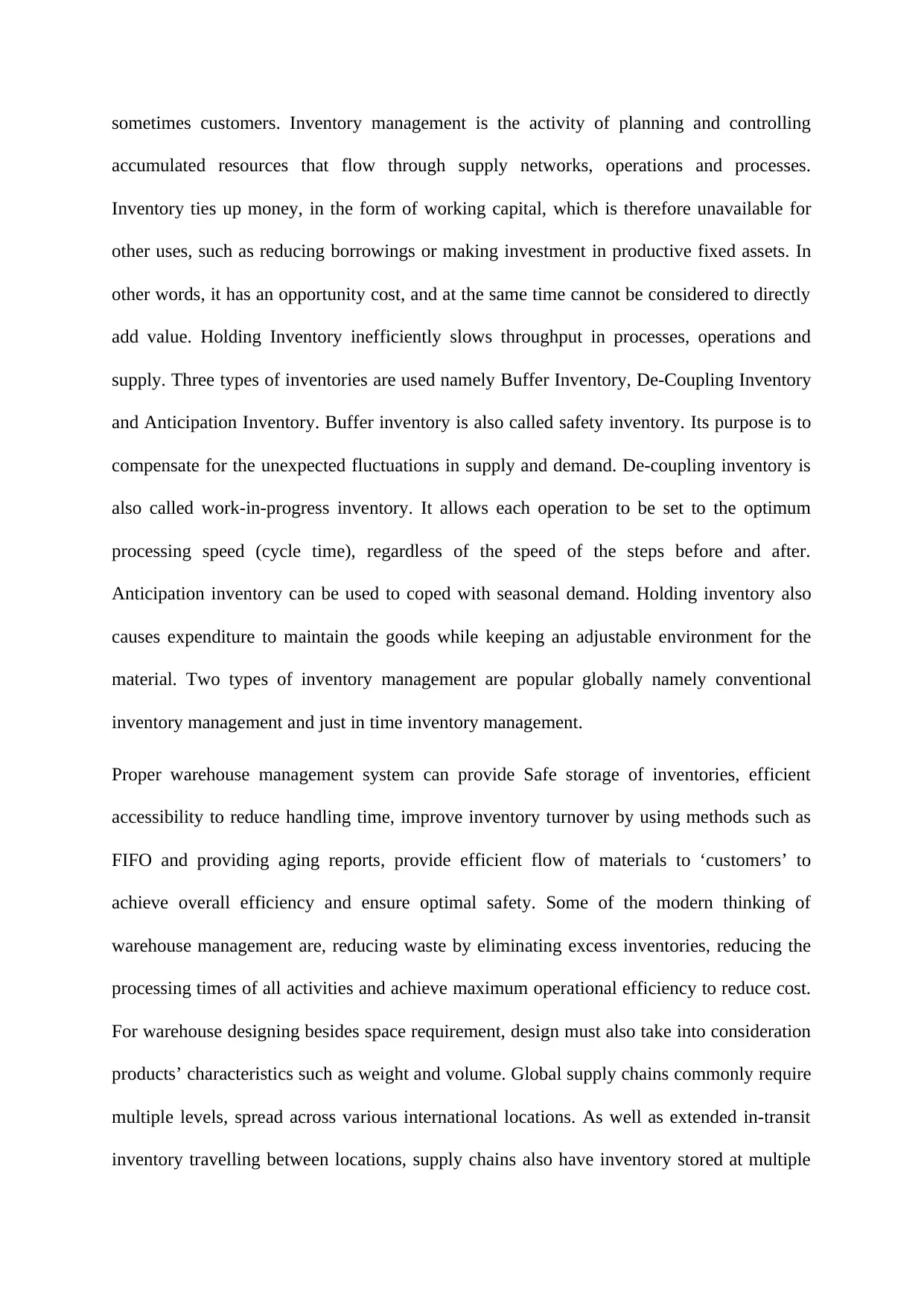
sometimes customers. Inventory management is the activity of planning and controlling
accumulated resources that flow through supply networks, operations and processes.
Inventory ties up money, in the form of working capital, which is therefore unavailable for
other uses, such as reducing borrowings or making investment in productive fixed assets. In
other words, it has an opportunity cost, and at the same time cannot be considered to directly
add value. Holding Inventory inefficiently slows throughput in processes, operations and
supply. Three types of inventories are used namely Buffer Inventory, De-Coupling Inventory
and Anticipation Inventory. Buffer inventory is also called safety inventory. Its purpose is to
compensate for the unexpected fluctuations in supply and demand. De-coupling inventory is
also called work-in-progress inventory. It allows each operation to be set to the optimum
processing speed (cycle time), regardless of the speed of the steps before and after.
Anticipation inventory can be used to coped with seasonal demand. Holding inventory also
causes expenditure to maintain the goods while keeping an adjustable environment for the
material. Two types of inventory management are popular globally namely conventional
inventory management and just in time inventory management.
Proper warehouse management system can provide Safe storage of inventories, efficient
accessibility to reduce handling time, improve inventory turnover by using methods such as
FIFO and providing aging reports, provide efficient flow of materials to ‘customers’ to
achieve overall efficiency and ensure optimal safety. Some of the modern thinking of
warehouse management are, reducing waste by eliminating excess inventories, reducing the
processing times of all activities and achieve maximum operational efficiency to reduce cost.
For warehouse designing besides space requirement, design must also take into consideration
products’ characteristics such as weight and volume. Global supply chains commonly require
multiple levels, spread across various international locations. As well as extended in-transit
inventory travelling between locations, supply chains also have inventory stored at multiple
accumulated resources that flow through supply networks, operations and processes.
Inventory ties up money, in the form of working capital, which is therefore unavailable for
other uses, such as reducing borrowings or making investment in productive fixed assets. In
other words, it has an opportunity cost, and at the same time cannot be considered to directly
add value. Holding Inventory inefficiently slows throughput in processes, operations and
supply. Three types of inventories are used namely Buffer Inventory, De-Coupling Inventory
and Anticipation Inventory. Buffer inventory is also called safety inventory. Its purpose is to
compensate for the unexpected fluctuations in supply and demand. De-coupling inventory is
also called work-in-progress inventory. It allows each operation to be set to the optimum
processing speed (cycle time), regardless of the speed of the steps before and after.
Anticipation inventory can be used to coped with seasonal demand. Holding inventory also
causes expenditure to maintain the goods while keeping an adjustable environment for the
material. Two types of inventory management are popular globally namely conventional
inventory management and just in time inventory management.
Proper warehouse management system can provide Safe storage of inventories, efficient
accessibility to reduce handling time, improve inventory turnover by using methods such as
FIFO and providing aging reports, provide efficient flow of materials to ‘customers’ to
achieve overall efficiency and ensure optimal safety. Some of the modern thinking of
warehouse management are, reducing waste by eliminating excess inventories, reducing the
processing times of all activities and achieve maximum operational efficiency to reduce cost.
For warehouse designing besides space requirement, design must also take into consideration
products’ characteristics such as weight and volume. Global supply chains commonly require
multiple levels, spread across various international locations. As well as extended in-transit
inventory travelling between locations, supply chains also have inventory stored at multiple
Paraphrase This Document
Need a fresh take? Get an instant paraphrase of this document with our AI Paraphraser
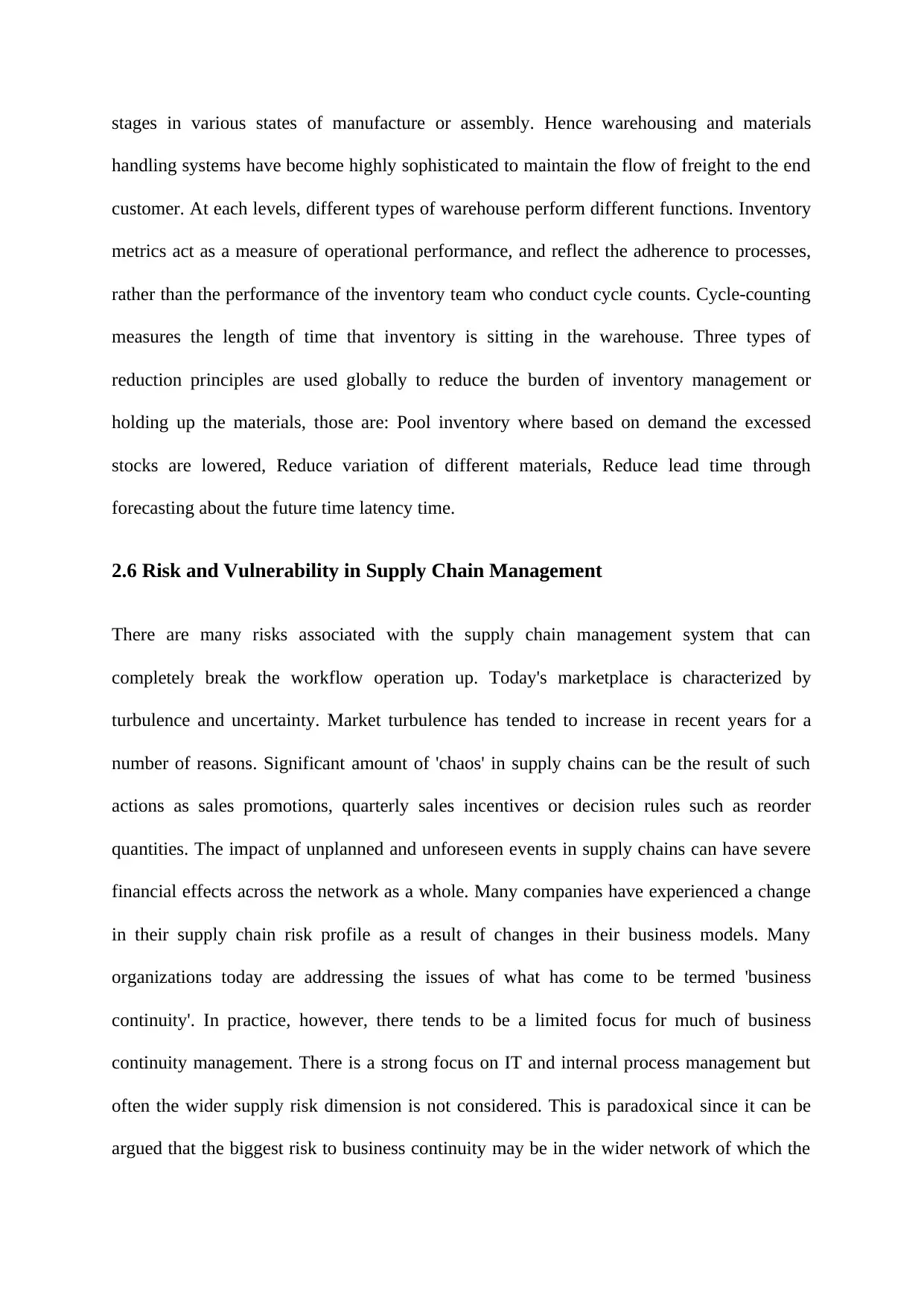
stages in various states of manufacture or assembly. Hence warehousing and materials
handling systems have become highly sophisticated to maintain the flow of freight to the end
customer. At each levels, different types of warehouse perform different functions. Inventory
metrics act as a measure of operational performance, and reflect the adherence to processes,
rather than the performance of the inventory team who conduct cycle counts. Cycle-counting
measures the length of time that inventory is sitting in the warehouse. Three types of
reduction principles are used globally to reduce the burden of inventory management or
holding up the materials, those are: Pool inventory where based on demand the excessed
stocks are lowered, Reduce variation of different materials, Reduce lead time through
forecasting about the future time latency time.
2.6 Risk and Vulnerability in Supply Chain Management
There are many risks associated with the supply chain management system that can
completely break the workflow operation up. Today's marketplace is characterized by
turbulence and uncertainty. Market turbulence has tended to increase in recent years for a
number of reasons. Significant amount of 'chaos' in supply chains can be the result of such
actions as sales promotions, quarterly sales incentives or decision rules such as reorder
quantities. The impact of unplanned and unforeseen events in supply chains can have severe
financial effects across the network as a whole. Many companies have experienced a change
in their supply chain risk profile as a result of changes in their business models. Many
organizations today are addressing the issues of what has come to be termed 'business
continuity'. In practice, however, there tends to be a limited focus for much of business
continuity management. There is a strong focus on IT and internal process management but
often the wider supply risk dimension is not considered. This is paradoxical since it can be
argued that the biggest risk to business continuity may be in the wider network of which the
handling systems have become highly sophisticated to maintain the flow of freight to the end
customer. At each levels, different types of warehouse perform different functions. Inventory
metrics act as a measure of operational performance, and reflect the adherence to processes,
rather than the performance of the inventory team who conduct cycle counts. Cycle-counting
measures the length of time that inventory is sitting in the warehouse. Three types of
reduction principles are used globally to reduce the burden of inventory management or
holding up the materials, those are: Pool inventory where based on demand the excessed
stocks are lowered, Reduce variation of different materials, Reduce lead time through
forecasting about the future time latency time.
2.6 Risk and Vulnerability in Supply Chain Management
There are many risks associated with the supply chain management system that can
completely break the workflow operation up. Today's marketplace is characterized by
turbulence and uncertainty. Market turbulence has tended to increase in recent years for a
number of reasons. Significant amount of 'chaos' in supply chains can be the result of such
actions as sales promotions, quarterly sales incentives or decision rules such as reorder
quantities. The impact of unplanned and unforeseen events in supply chains can have severe
financial effects across the network as a whole. Many companies have experienced a change
in their supply chain risk profile as a result of changes in their business models. Many
organizations today are addressing the issues of what has come to be termed 'business
continuity'. In practice, however, there tends to be a limited focus for much of business
continuity management. There is a strong focus on IT and internal process management but
often the wider supply risk dimension is not considered. This is paradoxical since it can be
argued that the biggest risk to business continuity may be in the wider network of which the
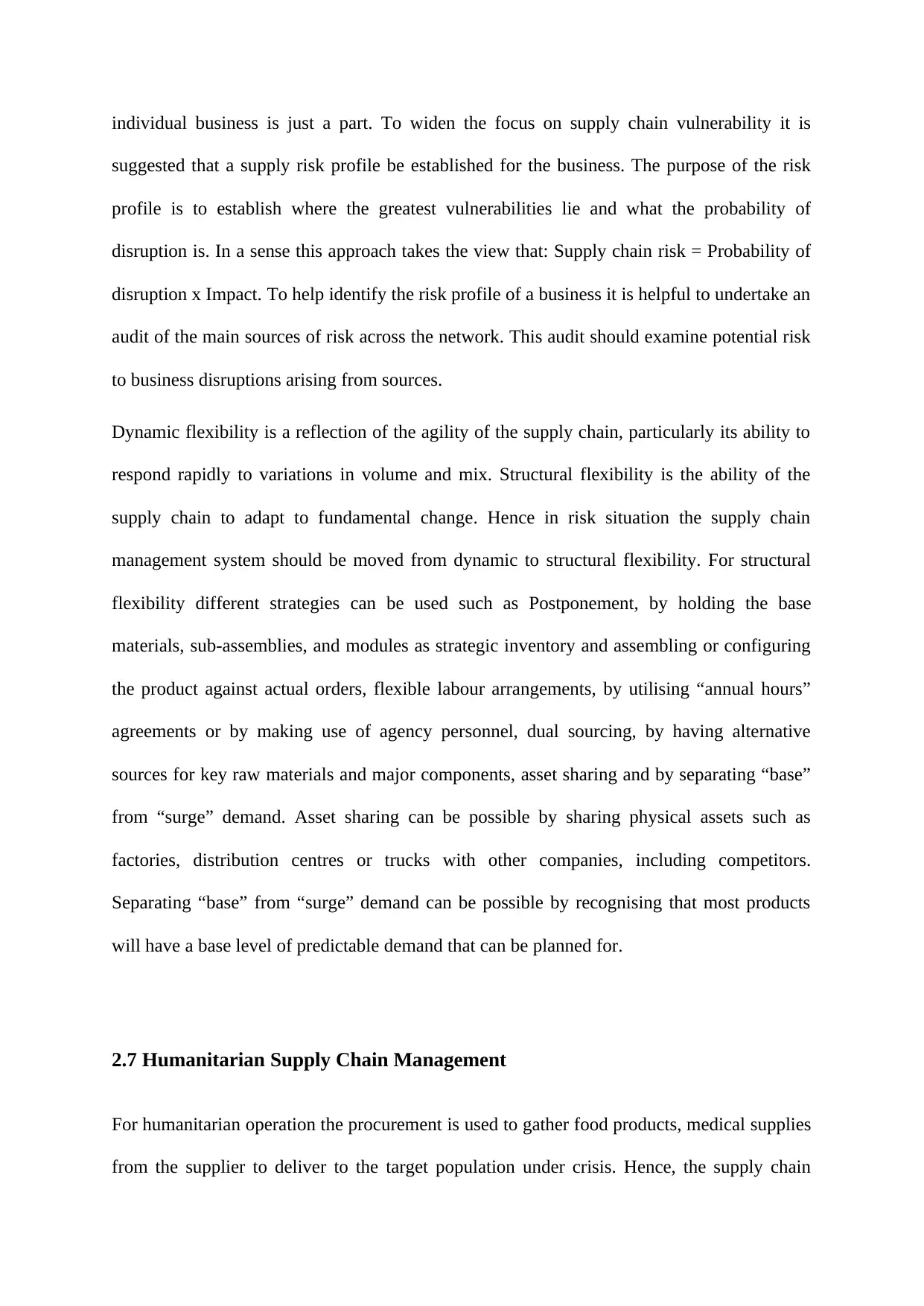
individual business is just a part. To widen the focus on supply chain vulnerability it is
suggested that a supply risk profile be established for the business. The purpose of the risk
profile is to establish where the greatest vulnerabilities lie and what the probability of
disruption is. In a sense this approach takes the view that: Supply chain risk = Probability of
disruption x Impact. To help identify the risk profile of a business it is helpful to undertake an
audit of the main sources of risk across the network. This audit should examine potential risk
to business disruptions arising from sources.
Dynamic flexibility is a reflection of the agility of the supply chain, particularly its ability to
respond rapidly to variations in volume and mix. Structural flexibility is the ability of the
supply chain to adapt to fundamental change. Hence in risk situation the supply chain
management system should be moved from dynamic to structural flexibility. For structural
flexibility different strategies can be used such as Postponement, by holding the base
materials, sub-assemblies, and modules as strategic inventory and assembling or configuring
the product against actual orders, flexible labour arrangements, by utilising “annual hours”
agreements or by making use of agency personnel, dual sourcing, by having alternative
sources for key raw materials and major components, asset sharing and by separating “base”
from “surge” demand. Asset sharing can be possible by sharing physical assets such as
factories, distribution centres or trucks with other companies, including competitors.
Separating “base” from “surge” demand can be possible by recognising that most products
will have a base level of predictable demand that can be planned for.
2.7 Humanitarian Supply Chain Management
For humanitarian operation the procurement is used to gather food products, medical supplies
from the supplier to deliver to the target population under crisis. Hence, the supply chain
suggested that a supply risk profile be established for the business. The purpose of the risk
profile is to establish where the greatest vulnerabilities lie and what the probability of
disruption is. In a sense this approach takes the view that: Supply chain risk = Probability of
disruption x Impact. To help identify the risk profile of a business it is helpful to undertake an
audit of the main sources of risk across the network. This audit should examine potential risk
to business disruptions arising from sources.
Dynamic flexibility is a reflection of the agility of the supply chain, particularly its ability to
respond rapidly to variations in volume and mix. Structural flexibility is the ability of the
supply chain to adapt to fundamental change. Hence in risk situation the supply chain
management system should be moved from dynamic to structural flexibility. For structural
flexibility different strategies can be used such as Postponement, by holding the base
materials, sub-assemblies, and modules as strategic inventory and assembling or configuring
the product against actual orders, flexible labour arrangements, by utilising “annual hours”
agreements or by making use of agency personnel, dual sourcing, by having alternative
sources for key raw materials and major components, asset sharing and by separating “base”
from “surge” demand. Asset sharing can be possible by sharing physical assets such as
factories, distribution centres or trucks with other companies, including competitors.
Separating “base” from “surge” demand can be possible by recognising that most products
will have a base level of predictable demand that can be planned for.
2.7 Humanitarian Supply Chain Management
For humanitarian operation the procurement is used to gather food products, medical supplies
from the supplier to deliver to the target population under crisis. Hence, the supply chain
⊘ This is a preview!⊘
Do you want full access?
Subscribe today to unlock all pages.

Trusted by 1+ million students worldwide
1 out of 23
Related Documents
Your All-in-One AI-Powered Toolkit for Academic Success.
+13062052269
info@desklib.com
Available 24*7 on WhatsApp / Email
![[object Object]](/_next/static/media/star-bottom.7253800d.svg)
Unlock your academic potential
Copyright © 2020–2025 A2Z Services. All Rights Reserved. Developed and managed by ZUCOL.





